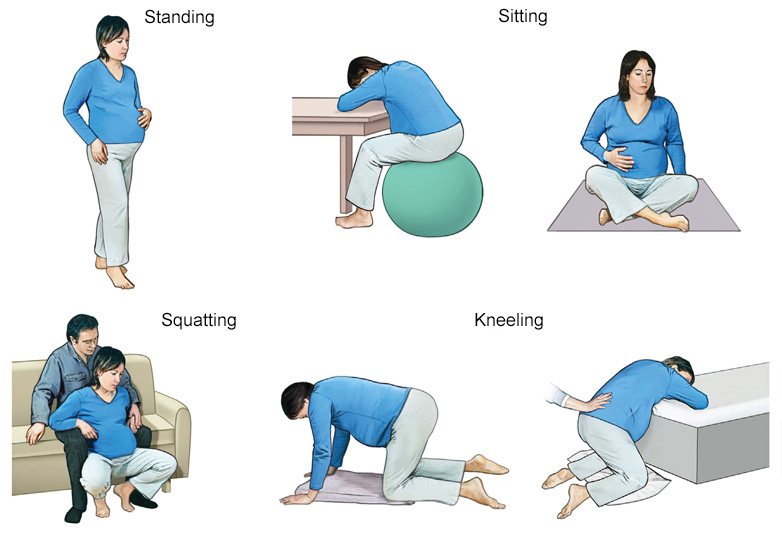Understanding and coping with pain
The pain of labour is unique and serves a purpose. It signals the start of the opening process that will lead to the birth of your baby. This process happens gradually. A rhythm develops and the intensity of the pain steadily increases.
The pain is stronger during contractions, while the period between contractions gives you time to recover. For some women the start of labour is hardest; for others the most difficult moment is when it is time to push.
There are various things that can help cope with childbirth pain without using medication. Knowing what they are can help women and couples better understand the pain and prepare in advance.
Having someone with you during childbirth
![]() You don’t need to be an expert to be useful during delivery. Don’t be afraid to try different things. Your partner will tell you what feels good. Keep supporting her and continue what you’re doing if your words and actions seem to be helping.
You don’t need to be an expert to be useful during delivery. Don’t be afraid to try different things. Your partner will tell you what feels good. Keep supporting her and continue what you’re doing if your words and actions seem to be helping.
During childbirth, a woman needs to feel the presence and support of someone she knows and trusts. This can be the baby’s father, the woman’s partner, a member of her family, a friend, or a doula (see Doulas). This presence will help her feel better, and reassure and encourage her during labour.
As a father or partner you may feel helpless and powerless during the birth, especially since this is an extremely important time for you. What do you do when the one you love is in pain and tells you she can’t take it anymore? How do you deal with all these emotions?
There’s no game plan that’s guaranteed to work, but you should know that your presence makes a big difference. Try to adopt a positive and caring attitude and encourage your partner as much as you can.
Creating a supportive environment
Women who give birth need an environment where they feel calm, safe and confident. This helps them to secrete the hormones needed for labour. To create a supportive environment, you can do things like dimming the lights and reducing ambient noise as much as possible (e.g. turning down the monitors, asking people to whisper).
Techniques for coping with childbirth pain
You can try various techniques to see what you find helpful for coping with the pain. Different things may work at different times during your labour.
Movement
Movement helps labour progress. During childbirth, you are encouraged to move, walk around, and squat. Find a comfortable position and don’t hesitate to switch from one position to another (see below Possible positions during labour). Large physio balls are usually available to sit and move around on. Don’t hesitate to ask for a ball if nobody offers one to you.
Using water

![]() Many women find that being in the water helps them cope with pain.
Many women find that being in the water helps them cope with pain.
Photo: Mélissa Bernard photographe
Most hospitals and birthing centres offer you the option of taking a bath or shower. Many women find that being in the water helps them cope with pain.
Massage
Gentle massage can help reduce anxiety and make the pain easier to bear. During contractions, some women prefer vigorous massage of painful areas or acupressure.
Compresses
Hot or cold compresses applied to painful areas can help reduce pain.
Relaxation methods
Some women learn relaxation methods such as breathing techniques, visualization, and self-hypnosis, or do yoga.
You can practice these methods during your pregnancy to help yourself prepare. During labour, listening to music and creating your own bubble of calm can also be soothing.
Other techniques
Some birthing facilities also offer injections of sterile water beneath the skin or the use of TENS machines, which electrically stimulate painful areas. If either of these methods interests you, don’t hesitate to ask your healthcare provider for more information.
If you get to a point where the methods for coping with the pain are no longer working or you feel like you can’t bear it any more, keep in mind that pain can often be relieved with drugs (see Pain medication).
Tips for coping with childbirth pain
- Have someone with you—the baby’s father, your partner, a family member, friend, or doula.
- Create a warm, calm, and intimate atmosphere.
- Stay warm.
- Trust yourself and your instincts.
- Stay in the moment.
- Visualize what is happening inside of you.
- Move and change positions as needed (don’t stay lying down)—walk around between contractions.
- Relax.
- Breathe slowly.
- Take a shower or bath.
- Eat and drink as needed.
- Make noise.
- Don’t hesitate to ask for whatever would make you feel better.
- Have someone encourage and comfort you through their words and actions.
- Have someone touch you, massage you, or simply hold your hand.
- Have someone sponge you with a wet compress.
Positions during labour

![]() Keeping your upper body straight can help speed up labour.
Keeping your upper body straight can help speed up labour.
Photo: Michaël Dufresne
Throughout labour, you can try different positions to help dilate the cervix and help you relax between contractions. Lying flat on your back is often the least comfortable position. If you feel the need to lie down, lying on your side is often more tolerable.
Whether you’re standing, squatting, sitting on a physio ball, or even kneeling on all fours, keeping your upper body straight can help speed up labour.
See below examples of the various positions you can try during labour.

Illustrations: Maurice Gervais
Acupressure: A method of applying pressure to a specific point on the body to reduce various symptoms.
Labour: Process by which the baby passes from the uterus to the outside world, primarily through contractions of the uterus.
Sterile: Product that is free of microorganisms and germs.


